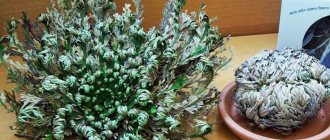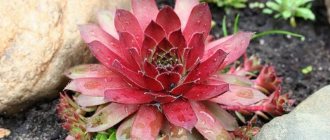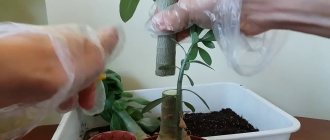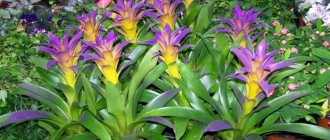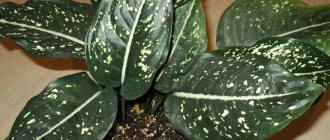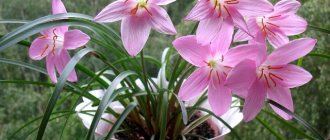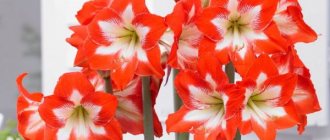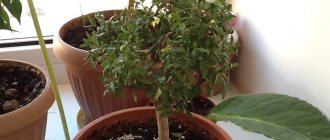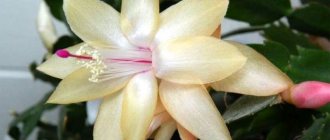Rose of Jericho is native to the Middle East. The botanical name is Anastatica Jericho, derived from the ancient Greek words for “again” and “revitalized.” According to legend, the Virgin Mary saw this plant on her way to Egypt and blessed it with eternal life. Hence another name - Egyptian rose.
This herbaceous plant is capable of growing in such harsh conditions where most plants die. How to grow the Rose of Jericho and how to care for it at home - later in this article.
Legends about the flower
The biblical version of the appearance of this flower claims that Mary discovered the unusual plant on her way to Egypt. She blessed him with immortality. Therefore, it is sometimes called the “hand of Mary.”
The second legend is described in the famous story “The Rose of Jericho” by Ivan Bunin. It says that the name of the herbaceous plant was given by the Monk Savva, who settled in the Judean desert.
Review: Houseplant “Rose of Jericho” – I’ve never seen anything like it before.
Home rose: types, planting, care at home
We bought these multi-colored dry lumps at the market during our next trip to Egypt
Before this, we went for several years, but never paid attention to them, or maybe they weren’t there before. It turns out that this is a dried plant, painted by local merchants with paints of different colors.
These flowers are sold in huge baskets right on the street. The choice of colors and sizes is huge, there are unpainted specimens. The price depends on the size of the flower and the ability to bargain. We bought 5 flowers (2 were given as gifts) for $2.
The flower is called the rose of Jericho. The Egyptians call it “the hand of the Virgin Mary” or “the hand of the Prophet.” According to legend, the Virgin Mary, on her way to Egypt, saw this flower in the desert and predicted a life with many resurrections for it. And indeed the rose of Jericho lives for about 30 years. During this time, it can dry out many, many times without water and bloom again when immersed in water for 1-2 hours. It will be interesting for children to watch this process, especially if they “have a hand in it.” The scientific name of the flower is Anastatica Jericho, and it is the only representative of this genus. It grows only in hot, arid deserts where rain is rare. And people call it tumbleweed. When a plant's leaves fall, the woody stems shrink into a tight ball and straighten out when immersed in water. You can find seeds inside and germinate them in the ground as usual. The locals have this custom. Inside the flower that is beginning to dry up, men hide a gift for their beloved, usually a ring, and give this rose of Jericho as a surprise. When dried, lignified branches are almost impossible to open. And in the water the rose blooms and “presents” a gift.
There is a belief that such a rose brings peace and tranquility to the house and gives happiness to all its inhabitants.
Here I put 3 dried flowers in a vase with water. Water volume 2 liters.
2 hours passed. The rose begins to bloom. Inside the flower, on the unpainted parts, I found several seeds and planted them.
Gradually the flowers increased in size and filled almost the entire vase. Our whole family goes and follows the process. Very interesting. The first time the water became a little stained, I changed it. It is recommended to change the water about once every 10 days. The photo shows that the vase is a little fogged up from cold water, which means you need to pour warm water.
Where should I put this flower? Maybe to the TV on a black background? In my opinion, not very much. Boring.
I decided to put it in a bright place on the dining table. Not bad. Unusual. Everyone is interested in what it is.
She put inside a magnet from the same Egypt with the inscription “Red Sea”. The fish look really good here.
Another day later my rose has grown a little, the vase is becoming small. Branches are already visible above the surface of the water. You need to take a larger vase. I also added shells from the Black Sea to the vase.
This is what a desert flower, rose of Jericho, Black Sea shells and an ordinary magnet look like together. Maybe tomorrow I'll come up with something else. And now it looks like this:
Description of the plant
Rose of Jericho (spike moss) is a species of herbaceous annuals of the Brassica family, a member of the genus Anastatica (“the only one”).
This is a small plant, no more than fifteen centimeters long. Small leaves of a grayish tint. The flowers of the plant are very small and white. The Rose of Jericho, the photo of which you see in our article, grows in the desert in early spring, and flowering and fruit set begin very quickly. At this time, there is still enough moisture in the desert for the plant. Like other herbaceous annuals that grow in drought conditions, the rose of Jericho is an ephemeral plant.
With the onset of drought, the tiny stems dry out and begin to curl inward. A kind of ball is formed. Strong gusts of wind easily tear off the top part of the plant, and it rolls along the sand. Along the way, it collects the same tangles and forms very large tumbleweeds. They move around until they get stuck in some wetter place. Due to humidity, the stems swell and begin to straighten, and the seeds spill out of them.
It should be noted that the seeds of this amazing plant remain viable for several years, but when placed in a sufficiently humid environment, they germinate in just a few hours.
You need to know that there is another representative of the flora with similar properties - squamosal selaginella. The Rose of Jericho is a completely different, unrelated plant, although the Hawaiian club moss is very similar in its life cycle and appearance to the anastatic plant.
Silaginella squamofolia
Rose Amadeus
Because the store sometimes sells silaginella squamofolia under the name Rose of Jericho.
It is displayed for sale in the same way as anastatica, rolled up into a ball. When placed in a humid environment, silaginella opens up and the leaves gradually turn green, with a beautiful emerald hue. It can be grown in soil with the addition of sand, sphagnum moss and peat.
Silaginella squamofolia
In nature it grows up to 10 cm in height, at home even less. Its diameter is about 40 cm. Silaginella has delicate leaves, giving it a fluffy appearance. It has this appearance during the rainy season; in hot weather the branches curl into a ball.
Note! The process of resurrecting a flower from a dry lump into a luxurious plant occurs within 24 hours.
Silaginella reproduces by dividing the bush, cuttings, and spores. Seed propagation is impossible because it does not have seeds. It grows quickly and reproduces easily. The shoots contain cell sap, which keeps the bush alive even after drying out. It is rich in oils and vitamins.
Kinds
There are several types of Rose of Jericho, so it is important to know their differences before deciding what kind of care a particular plant needs.
The most common type is Martens rose. It has erect stems that can reach a length of thirty centimeters, but gradually they become lodging. Its branches are slightly reminiscent of ferns, but the tips of the leaves are silvery-white in color.
Selaginella squamofolia has stems that do not grow more than ten centimeters in length. If the humidity in the room is insufficient, they curl into a ball, but as soon as the plant is watered, it immediately comes to life and scatters its leaves.
History and description of the Jericho rose
Botanically, the annual crop from the Cabbage family is known as Anastatica Jericho. From ancient Greek anastatica means “resurrected.” The plant was first mentioned in the Middle Ages, when during one of the Crusades across the Egyptian desert, knights discovered this amazing flower.
Rose of Jericho
- a mysterious flower of the desert
The rose of Jericho is often confused with selaginella or asteriscus. To understand the main differences, here is a brief description of anastatics:
- the size of the plant does not exceed 15 cm;
- leaves are small, gray-green;
- inflorescences are tiny, snow-white;
- fruits are pod-shaped, twisted.
Distribution area
The natural habitat of the rose of Jericho is the hot deserts of northern Africa and western Asia. Anastatica grows in Iran, Israel, and Morocco. The flower is most popular in Egypt. Here it is sold to tourists as an unusual curiosity that comes to life literally before our eyes upon contact with moisture.
The birthplace of the rose of Jericho is North Africa
Anastatica grows in Iran
In Egypt, the flower is sold to tourists
Life cycle of culture
The first shoots appear with the onset of spring, when the dry period has not yet begun. The plant actively grows, throws out flowers, and later bears fruit. With the advent of drought, the leaves curl up, forming a dry small ball. Taking off from the soil, he, driven by the wind, begins his journey through the desert. Having found a source of moisture, the anastatica comes to life again and drops seeds, which can lie in the sand for several years.
Benefits and uses of the plant
The inconspicuous-looking rose of Jericho can bring benefits to its owner. So, it has the following qualities:
- protection from moths and other harmful insects;
- absorption of unpleasant odor;
- air purification;
- decorating the room;
- improved sleep.
Growing
Rose of Jericho needs high humidity (at least 60%), so it does not feel very comfortable in indoor conditions. If you want to place this plant not in a florarium, but in an ordinary container, then you should know that with high humidity, good ventilation must be ensured. Place the pot in a tray with peat, sphagnum or expanded clay, which need to be moistened regularly.
It should be noted that the rose of Jericho is a shade-tolerant plant, so you can create a mini-garden placed in a bottle. It will feel fine even on the north side, and if your windows face south, then the plant should be placed away from the window or slightly shaded with gauze or tracing paper.
Another important argument in favor of placing a plant in a bottle is the need to constantly maintain a certain humidity of the substrate (over-drying it is unacceptable). And in an open container, constantly wet soil will be harmful to the plant and can even kill it.
The composition in the vessel (as in the container) should be watered with settled and soft water. Its temperature should be room temperature. The soil for growing roses should be slightly acidic; do not forget to place good drainage at the bottom of the bottle or aquarium.
For better growth, your green pet should be fed from time to time. This is usually done in spring and summer. Use diluted nutritious fertilizer (in a ratio of 1:3). Using a long wire, you should loosen the ground so that air penetrates better into the soil.
The most popular rose varieties for growing at home
Wild rose - what kind of flower is it, what is it called
Before purchasing a plant and deciding on the most optimal methods of care, every gardener needs to know how the popular varieties of this rose differ from each other.
Salaginella squamofolia
The plant can survive prolonged droughts. When exposed to moisture, it restores its green color. To do this, it needs about 24 hours. There is a version that Salaginella lepidoptera was able to survive for about 100 years without water and subsequently revived after soaking.
The plant can be grown at home in soil with the addition of peat, sand and sphagnum moss.
Asteriscus dwarf
An annual herbaceous plant. After flowering, an achene is formed, which persists for 10 months. It opens only when exposed to moisture. As a rule, this happens in the spring.
Varieties of the Rose of Jericho are considered false. Despite the fact that they are also capable of surviving and developing further at zero humidity.
Rose of Jericho in the desert
Rose of Jericho: care
This is a rather whimsical plant, so certain recommendations must be followed.
Temperature
The optimal temperature can be considered +18 degrees. The flower loves warmth, but the indicated indicators should not be exceeded, that is, the room should not be warmer than +20 °C.
Lighting
Rose of Jericho does not tolerate exposure to direct sunlight; light partial shade is much preferable.
Site selection and soil preparation
Jericho roses go on sale in the form of intertwined clumps formed by dried shoots.
To observe the amazing “resurrection” of a flower, you must:
- choose a shaded place in the room, away from sunlight and heating devices;
- place the “ball” in a bowl with a little water (no more than 2 cm), and after 24 hours, when the exotic blooms, move it to a container with sand with the addition of a small amount of pebbles.
This plant does not need fertilizers or any additional feeding, which is its undoubted advantage.
Important! The rose should only be placed in warm water.
Feeding and replanting
The soil should be fed monthly. You can use nitrogenous fertilizers. Once every two years (in spring), the rose of Jericho requires replanting to improve growth.
It must be said that the plant is resistant to various diseases and pests. Its only enemy is dry air, which can provoke the development of spider mites. A regular soap solution will help get rid of it.
The plant is propagated by green cuttings. To do this, in early spring, plant them in a small greenhouse and place it in the shade. The cuttings will take root in two weeks.
Growing problems, diseases and pests
Most often, the Egyptian rose becomes infected with fungal diseases. To avoid this kind of problem, you should periodically treat the plant with fungicides. To prevent the flower from rotting, the condition of its inflorescences must be monitored especially carefully. The formation of mold is strictly prohibited.
If you take good and proper care of a flower brought from Egypt, it will practically not hurt.
There are situations when spider mites appear on a dry rose. You can cope with the problem using a solution of laundry soap. These pests appear as a result of being in a room with dry air.
Important! After the life cycle, the plant requires a period of rest, which must be carefully ensured. You can prepare a flower for the dormant period in the fall by stopping watering it and reducing the humidity. As a result, the rose will take the shape of a ball, which can be stored in a dark place until spring.
Asteriscus dwarf
The exquisite and amazing rose of Jericho is rightfully considered an amazing plant that can exist for a century without water and then be reborn in just one day when moisture is supplied. Despite its name, the flower has absolutely no external resemblance to the usual rose. In nature, the plant travels across endless sands, attracting the attention of plant growers for many centuries. At the same time, it still remains a mystery how a plant can be lifeless, and then, when interacting with water, so quickly revive and bloom.
Hot chocolate capsules Nescafe Dolce Gusto Chococino, 8 servings
334 ₽ More details
Nesquik Opti-Start instant cocoa drink, 250 g (package)
125 ₽ More details
Green table lamps
Beneficial features
Rose of Jericho humidifies the air in the room and serves as a natural freshener, as it emits the aroma of steppe herbs. The plant has bactericidal properties and disinfects the air. In addition, it absorbs tobacco smoke. If a flower is placed in the bedroom, it will promote better sleep. In dried form, the annual can be used to combat moths in the closet.
Rose of Jericho is a very interesting and spectacular plant. With proper care, it will delight you with its exotic beauty.
General information
This extraordinary species of miniature plants with carved leaves cannot be classified as ferns or flowering species; they are classified as club mosses, which are an older group of plants.
The branches of this species are covered with numerous small leaves, which are similar to flat needles; they very often overlap each other like tiles.
When growing and caring for Selaginella at home, as a rule, the plant does not have enough air humidity, for this reason it is much better to grow them in florariums, bottle gardens, greenhouses or closed flower displays. In culture, these plants are used as soil cover plants or epiphytes.
Most often in indoor floriculture you can find Selaginella Martens - this plant is a soil cover plant with erect stems reaching up to 30 centimeters in length and aerial roots. The leaves are light green in color, and the watsoniana variety has silvery stem tips.
Contraindications and side effects
To date, scientists have not conducted much research on the safety of rose of Jericho, whether taken orally or applied to the skin.
Applying Rose of Jericho directly to the skin has no known risks, but it is best to avoid applying it to open cuts or wounds.
If you have diabetes, low blood pressure, high blood pressure, or other metabolic disorders, be sure to talk to your doctor before taking rose of Jericho to lower your blood sugar and blood pressure.
In addition, Rose of Jericho is a folk remedy for inducing labor, so you should consult your doctor before taking it. There is currently insufficient evidence of its safety.
If you have already taken rose of Jericho to induce labor, tell your doctor. It may affect the medications you take during labor. Unfortunately, there are no studies on its potential drug interactions ().
If you want to take rose of Jericho, talk to your doctor first, especially if you are pregnant or have a medical condition.
Conclusion:
Use caution when taking rose of Jericho during pregnancy, as there is limited research on its safety and because anecdotal reports say it may induce labor. If you are taking medications or have a medical condition, talk to your doctor first.
Application and dosage
People most often use the rose of Jericho as an ornamental plant and in various spiritual rituals. Many people believe that she:
- “Resurrects” areas of your life
- Brings good luck
- Protects you from negative energy or situations
In folk medicine, people most often consume it in the form of tea.
Only a few commercial products are available. That's why most people make it at home by buying dried rose of Jericho "flowers", which are actually small bunches of the plant.
Some unreliable sources claim that you can add 1 tablespoon (about 2 grams) of dried leaves or flowers to boiling water and let it steep for about 5 minutes. However, you can use smaller quantities at first.
Few skin care companies sell products containing rose of Jericho, which can make it difficult to obtain a skin care product that contains it. Additionally, there are no reliable recommendations for making any skin care products at home.
It is important to note that many products containing rose of Jericho actually contain false rose of Jericho (Selaginella lepidophylla). So, if you are looking for the real version, look for the name Anastatica hierochuntica or A. hierochuntica on the product label.
Conclusion:
People most often buy rose of Jericho in the form of dried leaves or flowers and prepare it as a tea. However, if you are looking for a true Rose of Jericho, make sure the label says Anastatica hierochuntica or A. hierochuntica.
Advantages and disadvantages of the plant
If you analyze all the positive and negative qualities of an unusual desert flower, then there are practically no disadvantages in its maintenance.
Pros:
- long life expectancy (more than 50 years);
- does not require constant watering;
- low maintenance;
- drought resistance;
- insecticidal properties;
- disinfects and refreshes indoor air.
Minuses:
- Without moisture, the rose of Jericho will not grow.
The plant is used to decorate the room
How to care at home: tips and tricks
You can learn how to care for the rose of Jericho at home from specialized literature. The following are expert advice and general recommendations that will help beginning gardeners cultivate this crop at home. Dry plant samples can be purchased at gardening stores. Such specimens, as a rule, have the shape of a small gray-brown ball rolled inward. This shape protects the plant from excessive evaporation, allowing it to survive long periods without water. For the bush to come to life, you need to put it in a plate and pour boiled water over it. After boiling, water must be cooled to room temperature. Watering with warm water speeds up the development process of the plant. Do not forget that only the roots of the plant need to be wetted in water. The gradual development of the plant can then be observed in real time. The shoots become light green and gradually darken.
After two months, the specimen is already fully developed, and its rosette reaches 25 centimeters in diameter. After a week we stop watering. The plant will gradually dry out and curl up into a ball. After 2-3 weeks it will take the form of a dry sample. We can carry out the process of revival and drying repeatedly, each time observing the miraculous resurrection of the flower.
The Rose of Jericho can remain without water for many months. An interesting fact is that miraculous revival occurs only in dead plants. The bush is dead and there is no point in planting it in a garden bed or pot.
